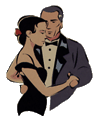 |
ROUND DANCING — CHOREOGRAPHED BALLROOMEDUCATIONAL ARTICLESMAJOR SECTIONS: Figures | Articles | Links | Alph. Index | Search | Home |
|
|
Is A Hip Twist Just A Fancy Half Basic?by Harold & Meredith Sears One way to think about the Hip Twists in Rumba is to see them growing out of the phase-III Half Basic. We might begin the Half Basic in butterfly position facing the wall. The man steps forward on his left foot, and the woman steps back right. We both recover onto our trail feet and then step side (quick, quick, slow). The Forward Basic is similar, but the man steps forward, recover, and then back. One simple way to add a bit of styling to these and other Rumba figures is to step with the toes turned a little outward. This small change turns the hips too and gives them a little rocking motion as you step. You will dance: step/hip, step/hip — very Latin. To change a Half Basic into an Open Hip Twist, we might begin in left open facing position, again facing wall. The man steps forward left (woman back right), and we both recover. So far, it’s just a Basic, right? Then the man slips his left foot back but not quite to his supporting right foot, and he keeps good muscle tone throughout his upper body. The woman takes her third step, a forward right toward her man, and she meets a barrier. He is not a rigid wall, but his slipping action has moved him just a little toward her, she meets this pressure through their joined lead arms, and the result is that she turns sharply to the right — the Hip Twist just happens. Ladies, let your hips turn fully 1/4, but turn your upper body less. Your lead hands are joined, giving you a connection to your partner. You have a psychological connection, too — you don’t want to turn fully away.A Closed Hip Twist begins in closed position and it involves a little more “body action.” The steps for the man are side and forward left, recover right, and then close left to right. That’s pretty much like a Half Basic. But … he needs to give her his left side, that is, turn a little to the right, as he takes his first step. This causes the woman to turn on her left foot and then to step back right. This first step has a little of the feel of lunging apart, and at the end of the step the man might be facing reverse and wall and the woman line and wall in almost a half-open position (but keep lead hands joined). Next, we both recover, and the man turns back to the left to lead the woman to face him again. On the slow count, he closes left to right, and he gives her his left side again and also stretches his right side. She steps side right, and his body action leads her right-face Hip Twist at the end of the slow count. Again, maintain that upper-body connection. The Advanced Hip Twist (phase VI) is also
quite a bit more than just a “Half Basic with a Twist.” Again, we begin
in closed position. The man steps forward left, pressing into the
floor. He lowers the lead hands and uses left side lead to cause her to
open out, and the woman swivels fully 1/2 to the right and steps back
on her right foot. So this first step isn't greatly different than in
the Closed Hip Twist. The man steps forward instead of side, and the
woman opens 1/2 instead of 1/4 or maybe 3/8. The second step is a
recover right for the man and a recover left, turning back to face, for
the woman. Here, the man needs to loosen his right arm hold so she will
dance, not to closed position, but more to his right side. Finally, the
man steps back left, leading the woman to step forward right outside
his right foot. He takes this third step well under his body with a
pressing or checking action so that his body weight does not fall back,
and he turns a little right, and uses right-side stretch to clearly
lead her Hip Twist at the end of the measure.
This article was
published in the Washington Area Square Dancers
Cooperative Association (WASCA) Calls 'n'
Cues, 48-6:9, 2/2008; and reprinted 2nd quarter newsletter, North
Carolina Round Dance Association, April 2011; CRDA Round Notes Aug/Sept 2015; and DRDC Newsletter May 2021.
If you would like to read other articles on dance position, technique, styling, and specific dance rhythms, you may visit the article TOC. Past DRDC Educational Articles archived here. Go beyond this site. Find other references on our Sources and Links pages.
|
 |
|
|